
Megophryidae, commonly known as goose frogs, is a large family of frogs native to the warm southeast of Asia, from the Himalayan foothills eastwards, south to Indonesia and the Greater Sunda Islands in Maritime Southeast Asia, and extending to the Philippines. Fossil remains are also known from North America. As of 2014 it encompasses 246 species of frogs divided between five genera. For lack of a better vernacular name, they are commonly called megophryids.

Sooglossidae, the Seychelles frogs or Seychelles Island frogs, are a family of frogs found on the Seychelles Islands. Until recently, this family was believed to include the genera Sechellophryne, Nesomantis and Sooglossus, but following a major revision of amphibians in 2006, the genus Nesomantis was named a junior synonym of Sooglossus. Their closest relatives are the purple frogs (Nasikabatrachidae) of India.

The Microhylidae, commonly known as narrow-mouthed frogs, are a geographically widespread family of frogs. The 683 species are in 57 genera and 11 subfamilies.

Tomato frogs are any of the three species of genus Dyscophus : D. antongilii, D. insularis, or D. guineti. Dyscophus is the only genus in subfamily Dyscophinae. They are endemic to Madagascar.

Chrysopelea ornata is a mildly venomous opisthoglyphous (rear-fanged) colubrid snake found in both South and Southeast Asia. It is commonly known as the golden tree snake, ornate flying snake, and golden flying snake. Along with the other species in the Chrysopelea genus, the golden tree snake is very unusual, as it is capable of a type of gliding "flight" —mainly utilised during the pursuit of prey animals—from tree-to-tree. This action is also used to great effect for the snake to flee its own potential predators. Currently, three subspecies are recognised. The snake's striking looks, and potential for gliding, have made it a coveted choice for captivity.

Micrixalus is a genus of frogs from that are endemic to the Western Ghats in India. They are monotypic within the family Micrixalidae. Before being raised to the family level they were classified as the subfamily Micrixalinae within Ranidae. Micrixalus frogs, such as Micrixalus saxicola, are popularly known as "dancing frogs" due to their peculiar habit of waving their feet to attract females during the breeding season. Dancing frogs are extremely vulnerable as their habitat is severely threatened.

The banded bullfrog is a species of frog in the narrow-mouthed frog family Microhylidae. Native to Southeast Asia, it is also known as the Asian painted frog, digging frog, Malaysian bullfrog, common Asian frog, and painted balloon frog. In the pet trade, it is sometimes called the chubby frog. Adults measure 5.4 to 7.5 cm and have a dark brown back with stripes that vary from copper-brown to salmon pink.

Microhyla, commonly known as the rice frogs or narrow-mouthed frogs, is a genus of frogs in the family Microhylidae. It consists of 42 species of diminutive frogs. Members of this genus are widespread from Ryukyu Is. in Japan, and throughout South-east Asia,.
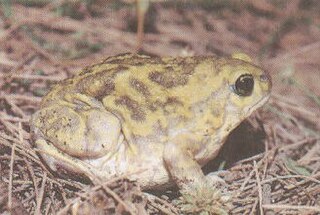
Uperodon is a genus of microhylid frogs. They occur in South Asia and Myanmar. Uperodon reached its current composition in 2016 when the genus Ramanella was brought into its synonymy. The common names of these frogs are globular frogs and balloon frogs in reference to their stout appearance, or dot frogs, the last specifically referring to the former Ramanella.

Microhyla ornata, commonly known as the ornate narrow-mouthed frog, ornate narrow-mouthed toad, or ornamented pygmy frog, is a species of microhylid frog found in South Asia. This amphibian is distributed in Kashmir, Nepal, peninsular India and the Andaman and Nicobar Islands, Sri Lanka, and Bangladesh. It was previously considered to be the same species as Microhyla fissipes; therefore, the aforementioned common names can refer to either species.
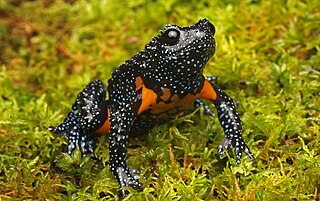
Melanobatrachus is a genus of narrow-mouthed frogs in the family Microhylidae. It is the only remaining genus in the monotypic subfamily Melanobatrachinae. It contains a single species, Melanobatrachus indicus, also known as the Indian black microhylid frog and Malabar black narrow-mouthed frog. It is endemic to wet evergreen forests of southern Western Ghats in Kerala and Tamil Nadu states of India. It has been recorded from Anaimalai, Munnar, Palni hills, Periyar Tiger Reserve and Kalakkad Mundanthurai Tiger Reserve

Uperodon taprobanicus, also known as the Sri Lankan bullfrog, Sri Lankan painted frog, Sri Lankan kaloula, Ceylon kaloula, Indian painted frog, or painted globular frog, is a species of narrow-mouthed frog found in Nepal, Bangladesh, southern and eastern India, and Sri Lanka up to an altitude of about 1300 metres. It can grow to an adult length of up to 75 millimetres(7.5 cm) long from snout to vent. It was originally described as a subspecies of Kaloula pulchra, ssp. taprobanica. The IUCN lists it as being of "Least Concern".

Indosylvirana aurantiaca, commonly known as the golden frog, is a species of frog endemic to the Western Ghats of India. The species is also known as the Trivandrum frog, the common wood frog, or the small wood frog.
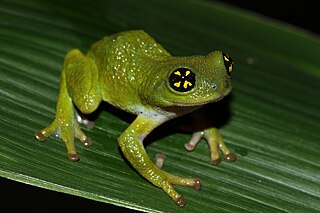
Raorchestes chalazodes is a species of critically endangered frog in the family Rhacophoridae. Raorchestes chalazodes is a nocturnal and arboreal species found in the understorey of tropical moist evergreen forest and is endemic to the Western Ghats of India. The specific name chalazodes is composed of the Greek word χάλαζα (chalaza) meaning "lump" and -odes for the derived adjective, reflecting white granulation of the body. It has been observed between 1200 and 1600 meters above sea level.
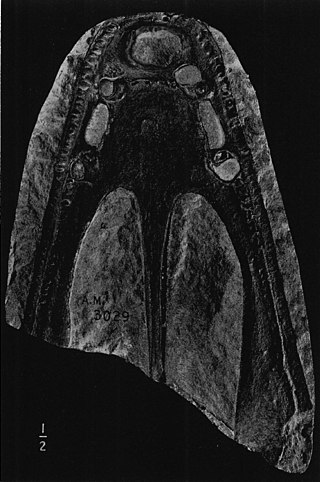
Stanocephalosaurus is an extinct genus of large-sized temnospondyls living through the early to mid Triassic. The etymology of its name most likely came from its long narrow skull when compared to other temnospondyls. Stanocephalosaurus lived an aquatic lifestyle, with some species even living in salt lakes. There are currently three recognized species and another that needs further material to establish its legitimacy. The three known species are Stanocephalosaurus pronus from the Middle Triassic in Tanzania, Stanocephalosaurus amenasensis from the Lower Triassic in Algeria, and Stanocephalosaurus birdi, from the middle Triassic in Arizona. Stanocephalosaurus rajareddyi from the Middle Triassic in central India needs further evidence in order to establish its relationship among other Stanocephalosaurs. Like other temnospondyls, Stanocephalosaurus was an aquatic carnivore. Evidence of multiple species discovered in a wide range of localities proves that Stanocephalosaurus were present all across Pangea throughout the early to mid Triassic.

Microhyla fissipes is a microhylid frog from East and Southeast Asia, from southern and central China and Taiwan to the Malay Peninsula. It was previously considered to be the same species as Microhyla ornata of South Asia; thus the common names ornate narrow-mouthed frog or ornamented pygmy frog can refer to either species.

Robert Frederick Inger was an American herpetologist. During his lifetime, he wrote numerous books and publications about herpetology. He was also the curator for amphibians and reptiles at the Field Museum in Chicago, Illinois.

Raorchestes is a genus of frogs in the subfamily Rhacophorinae that are found in mountainous regions of South Asia, Southeast Asia, and southern China. A recent study places Raorchestes as a sister taxon of Pseudophilautus. Before the description of the genus in 2010, species now in Raorchestes had been assigned to genera Ixalus, Philautus, and Pseudophilautus.
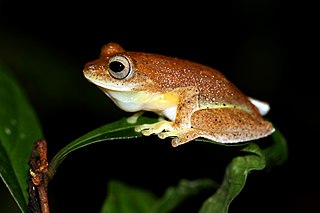
Mercurana is a genus of arboreal frogs belonging to the family Rhacophoridae. The genus was named from the only known species Mercurana myristicapalustris, which was described in 2013 from the Western Ghats of Kerala, India. The generic name was derived from and given as a tribute to Freddie Mercury, the late vocalist of the British rock band Queen, in combination with the Latin name for "frog". The frog is different from other related frogs in that it has extensively webbed toes, lives only in swampy lowlands, and lays its eggs on mud with which it carefully mixes leaf litter.
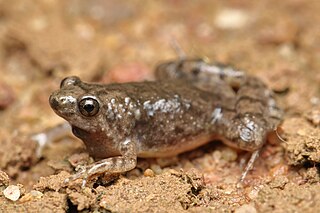
Microhyla kodial, the Mangaluru narrow-mouthed frog, is a frog species belongs to family Microhylidae. It is likely endemic to a small portion of India, and was discovered in the urban part of Mangalore. This new discovery was published at international journal Zootaxa on Tuesday May 16, 2018.




















